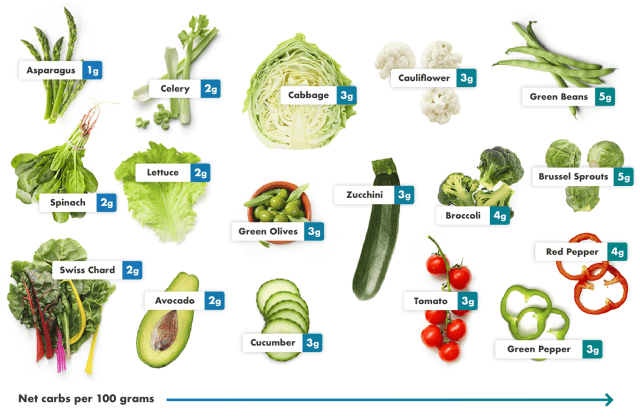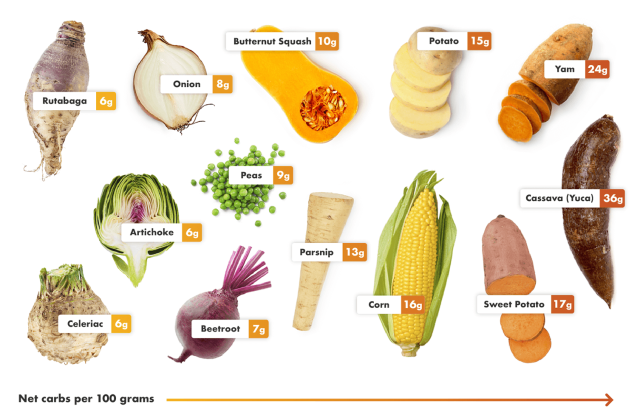What this page contains:
- What are Foundation Vegetables?
- Which vegetables are not Foundation Vegetables?
- Importance of Foundation Vegetables
- How to incorporate Foundation Vegetables
- Carbohydrate content of Foundation Vegetables
What are Foundation Vegetables?
Foundation Vegetables are non-starchy vegetables that serve as a cornerstone of the Atkins Approach at all phases. This includes leafy greens, asparagus, peppers, celery, cucumbers and cruciferous vegetables such as broccoli and cauliflower. Avocados and olives are also considered Foundation Vegetables due to their low carbohydrate content.

A general rule to remember is that Foundation Vegetables tend to grow above-ground. Vegetables that grow in the ground—generally, root vegetables—are higher in starch and are not considered Foundation Vegetables.
These vegetables are included in all Atkins plans and phases, beginning in Phase 1 of Atkins 20®. A full list of Foundation Vegetables and their carbohydrate content is provided below.
Which vegetables are not Foundation Vegetables?
Limiting carbohydrate intake is a main principle of the Atkins Approach. While vegetables are an importance source of nutrition, some vegetables are not considered Foundation Vegetables because of their relatively higher carbohydrate content.
Root vegetables, such as potatoes, sweet potatoes, parsnips, carrots and beets are not Foundation Vegetables. Most winter squashes, such as butternut squash, are also too high in carbohydrates to be Foundation Vegetables.

These vegetables may be incorporated in Phase 3 and 4 of Atkins 20® and more flexibly in Atkins 40® and Atkins 100®.
Importance of Foundation Vegetables
Foundation Vegetables are the nutrient-dense, higher-fiber foundation for the Atkins way of eating.
These vegetables provide the body with antioxidants, vitamins, minerals and fiber in combination with the fewest grams of carbs. Along with protein and healthy fats, Foundation Vegetables are a cornerstone of the Atkins Lifestyle.
Foundation Vegetables are essential to the Atkins Approach for several reasons.
- Due to the fiber content, Foundation Vegetables can help promote satiety and regularity. Following a low carbohydrate diet has even been found to increase daily fiber intake from baseline (1).
- Foundation Vegetables can help in meeting micronutrient needs, as they contain essential vitamins and minerals including vitamins A, C and K, potassium, magnesium, iron and calcium (2).
- Foundation Vegetables provide health-supporting phytonutrients such as carotenoids, flavonoids, glucosinolates and more. These compounds are linked to a host of health benefits thanks to their antioxidant and anti-inflammatory activities (3).
How to Incorporate Foundation Vegetables
Foundation Vegetables play a pivotal role in the Atkins Nutritional Approach, so it’s essential to include them in daily meals and snacks.
Here are a few ideas for how to incorporate Foundation Vegetables into delicious low-carbohydrate eating.
- Fold bell peppers and spinach into omelets.
- Use cauliflower rice in place of rice.
- Make zucchini fries in an air fryer.
- Have spaghetti squash in place of pasta.
- Snack on sliced cucumbers and guacamole.
- Include a side salad at meals.
Find more inspiration for ways to use Foundation Vegetables on our recipes page.
Carbohydrate content of Foundation Vegetables
Here is a list of Foundation Vegetables and their carbohydrate content per serving size.
| FOUNDATION VEGETABLES | NEW SERVING SIZE | NET CARBS |
|---|---|---|
| Alfalfa sprouts (raw) | 1/2 cup | 0 |
| Chicory greens (raw) | 1/2 cup | 0.1 |
| Endive (raw) | 1/2 cup | 0.1 |
| Escarole (raw) | 1/2 cup | 0.1 |
| Olives, green | 5, each | 0.1 |
| Watercress (raw) | 1/2 cup | 0.1 |
| Arugula (raw) | 1/2 cup | 0.2 |
| Radishes (raw) | 1, each | 0.2 |
| Spinach (raw) | 1/2 cup | 0.2 |
| Bok choy (cooked) | 1/2 cup | 0.4 |
| Lettuce, average (raw) | 1/2 cup | 0.5 |
| Turnip greens (cooked) | 1/2 cup | 0.6 |
| Heart of palm | 1, each | 0.7 |
| Olives, black | 5, each | 0.7 |
| Radicchio (raw) | 1/2 cup | 0.7 |
| Button mushroom (raw) | 1/2 cup | 0.8 |
| Artichoke (marinated) | 1, each | 1 |
| Celery (raw) | 1 stalk | 1 |
| Collard greens (cooked) | 1/2 cup | 1 |
| Pickle, dill | 1, each | 1 |
| Spinach | 1/2 cup | 1 |
| Broccoli rabe (cooked) | 1/2 cup | 1.2 |
| Sauerkraut (drained) | 1/2 cup | 1.2 |
| Avocado, Haas | 1/2 fruit | 1.3 |
| Daikon radish, grated (raw) | 1/2 cup | 1.4 |
| Red/white onion, chopped (raw) | 2 TBSP | 1.5 |
| Zucchini (cooked) | 1/2 cup | 1.5 |
| Cucumber, sliced (raw) | 1/2 cup | 1.6 |
| Cauliflower (cooked) | 1/2 cup | 1.7 |
| Beet greens (cooked) | 1/2 cup | 1.8 |
| Broccoli (cooked) | 1/2 cup | 1.8 |
| Fennel (raw) | 1/2 cup | 1.8 |
| Okra (cooked) | 1/2 cup | 1.8 |
| Rhubarb (raw) | 1/2 cup | 1.8 |
| Swiss chard (cooked) | 1/2 cup | 1.8 |
| Asparagus (cooked) | 6 stalks | 1.9 |
| Broccolini (cooked) | 3, each | 1.9 |
| Bell pepper, green, chopped (raw) | 1/2 cup | 2.2 |
| Sprouts, mung beans (raw) | 1/2 cup | 2.2 |
| Eggplant (cooked) | 1/2 cup | 2.3 |
| Kale (cooked) | 1/2 cup | 2.4 |
| Scallion, chopped (raw) | 1/2 cup | 2.4 |
| Turnip (cooked) | 1/2 cup | 2.4 |
| Tomato, small (raw) | 1, each | 2.5 |
| Jicama (raw) | 1/2 cup | 2.6 |
| Portobello mushroom (cooked) | 1, each | 2.6 |
| Yellow squash (cooked) | 1/2 cup | 2.6 |
| Cabbage (cooked) | 1/2 cup | 2.7 |
| Green beans (cooked) | 1/2 cup | 2.9 |
| Bell pepper, red, chopped (raw) | 1/2 cup | 3 |
| Leeks (cooked) | 2 TBSP | 3.4 |
| Shallot, chopped (raw) | 2 TBSP | 3.4 |
| Brussels sprouts (cooked) | 1/2 cup | 3.5 |
| Spaghetti squash (cooked) | 1/2 cup | 4 |
| Cherry tomato | 10, each | 4.6 |
| Kohlrabi (cooked) | 1/2 cup | 4.6 |
| Pumpkin, mashed (cooked) | 1/2 cup | 4.7 |
| Garlic, minced (raw) | 2 TBSP | 5.3 |
| Snow peas (cooked) | 1/2 cup | 5.4 |
| Tomato (cooked) | 1/2 cup | 8.6 |
